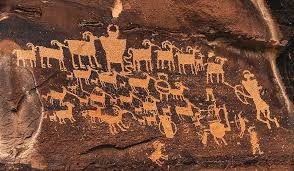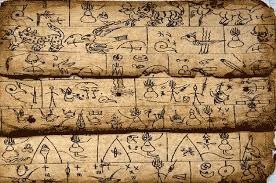Primitive times
With the origin of speech around 500,000 BCE[citation required], human communication was revolutionized. Around 30,000 years ago, symbols were created. The imperfection of expression made it easier to disseminate thoughts and gradually contributed to the development of new modes of communication, improving both the range of communication and the longevity of knowledge. Many of those developments were based on the symbol’s main idea.
Cave paintings, a type of rock art dating to the Upper Paleolithic period, were the oldest known symbols produced for communication. Within Chauvet Cave, the oldest known cave painting is dated to about 30,0000 BC.
Petroglyphs
In communications history, the next breakthrough came with the development of petroglyphs, carvings into a rock surface. It took about 20,000 years for homo sapiens to switch from the first cave paintings to the first petroglyphs, dating from about 10,000 to 12,000 years ago to about the Neolithic and late Upper Paleolithic borders.
Several other means of communication were likely used by Homo sapiens (humans) of that period, mostly for mnemonic purposes – specially arranged stones, symbols carved in wood or earth, quipu-like cords, tattoos, but only the most durable carved stones survived in modern times.
Pictograms
A pictogram (pictograph) represents an illustrated idea, entity, action, location, or event. Pictography is a proto-writing type in which thoughts are conveyed by drawing. The next step in the evolution of communication was pictographs: the most significant difference between petroglyphs and pictograms is that petroglyphs merely show an occurrence, whereas pictograms tell a tale about the event, so they can be arranged chronologically, for example.
Since around 9000 BC, pictograms have been used by various ancient cultures worldwide, when tokens marked with simple images began to be used to label basic farm products and became increasingly common around 6000-5000 BC.
Ideograms
In turn, pictograms have grown into ideograms, graphical symbols representing a concept. Their predecessors, the pictograms, could only reflect anything close to their shape: so a circle pictogram could represent a sun, but not concepts such as ‘heat,” light,” day’ or ‘Great Sun God.’ On the other hand, ideograms may express more abstract ideas, such that an ideogram of two sticks, for instance, would mean not only ‘legs’ but also a ‘to walk’ verb.
Since certain concepts are universal, similar ideograms have been created by many distinct cultures. For instance, in Native American ideograms in California, an eye with a tear means’ sorrow,’ as it does for the Aztecs, the early Chinese, and Egyptian.






